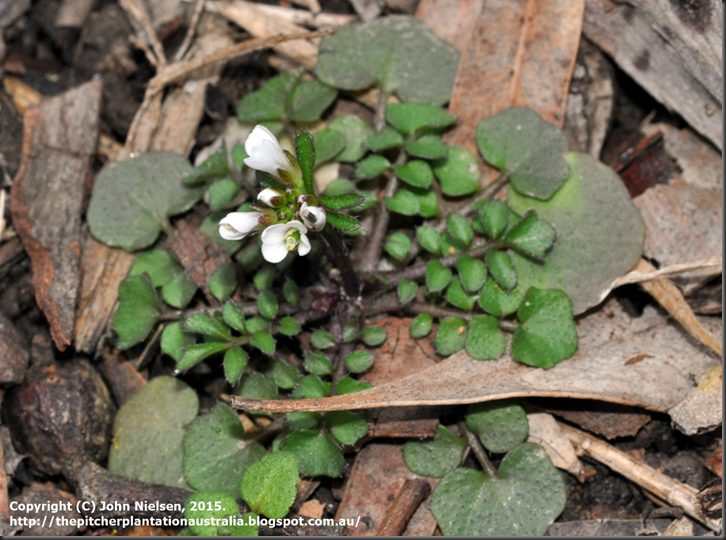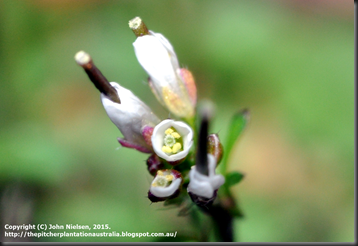Vertical gardens are fast becoming all the rage, especially as new houses have less and less space for gardening. There are numerous designs to be found by searching on Google images, with new ones appearing regularly. Even though we are lucky to have a good sized garden, only a small area of it is really suitable for CPs, and it is pretty much filled by the four bog gardens. One thing about bog gardens is that the smaller plants in them, like VFTs, can easily be swallowed up by large plants like Sarracenia. So, to show off these plants better, I decided to try making my own vertical garden from some scrap pipe I had lying around (as well as to see if vertical gardens work for CPs).
Note: this is experimental for CPs. I have never used one of these gardens before for them. Try at your own risk, as it is untested! For those more patient, I will report back whether it works or not.
Also: your safety is your responsibility.
To make a pipe vertical garden, you will need:
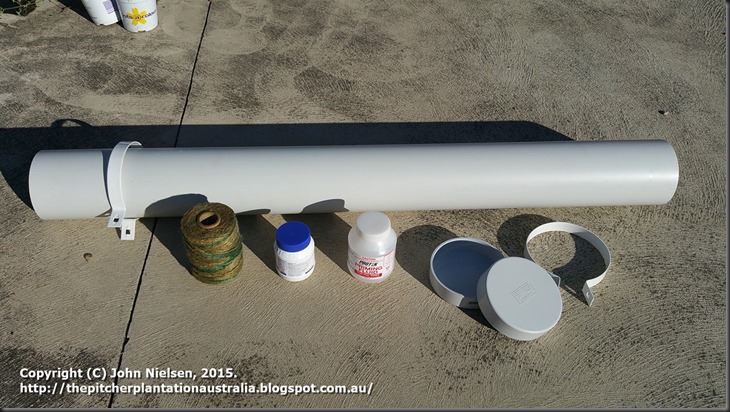
- 1 meter (3 foot) lengths of 100mm (4”; for VFTs or sundews) or 150mm (7”; for Sarracenia) PVC pipe
- PVC primer
- PVC glue (for non-pressure pipe)
- Two end caps for each length of pipe
- Two downpipe C-clamps for each length of pipe (choose an attachment type for your particular situation; mine are good for a horizontal runner, but other types are available for vertical surfaces)
- 60 mm treated pine screws (you will need other fasteners if you are attaching to brickwork)
- Washers of appropriate size for the screws
- Garden twine
- A gardening pen (or at least a pen that makes a permanent mark on plastic)
- High speed electric drill + extension cord
- A 76 mm (3”) or 125 mm (4.8”) hole saw
- Drill bits
- Safety glasses
- Tape measure or ruler
- Acrylic or spray paint of a light colour (or not).
To start, you will need to figure out how to space out the centre of each hole. For a 1 metre pipe and 76 mm holes, the below spacing worked for me (assuming you loose 30 mm to each end cap):

The design I am making is specifically for VFTs but would also work for Drosera. If you want to try Sarracenia in a pipe garden, I would use 125 mm holes (5”) and 150 mm pipe (the depth will hold a lot more water). Approximate hole spacings for such a garden are given below, including separate holes for smaller Sarracenia species only, and overlapping holes for larger plants. For the overlapping hole design, you could use some wet and dry sandpaper or a file to round down the v-shaped intrusions and make a nicer hole (or the hole saw if you are really, really careful).
In case these layouts don’t work for you, I used Powerpoint to lay everything out and figure out the spacings. But note also that, no matter how careful you are, the holes will never be perfectly spaced, but close enough is good enough in this instance…
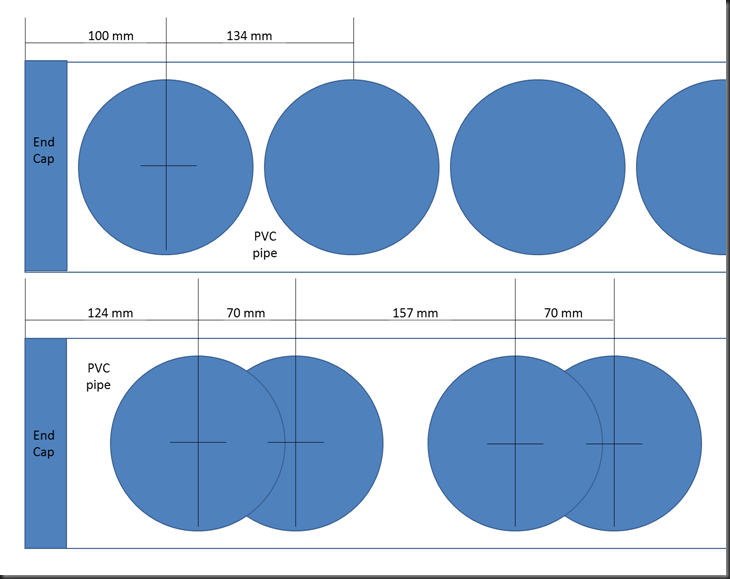
Now comes the tricky part: lining the centres up perfectly straight. To do this, I used garden twine to make a straight line. Do this by threading a length of twine two and a bit times the length of your pipe through the pipe, and tying a knot so it sits tight against the end of the pipe. This will create your straight line. Adjust if the string is not tight enough to make it perfectly straight, and then go ahead and mark out your hole centers with the pen and ruler, like this:

Now comes the fun part: the drilling. Do this outside, as it will produce lots and lots of plastic shavings and burrs that are messy to clean up. Also, before you fit on the hole cutting bit, it pays to pre-drill each hole, first using a small bit to make precisely laid-out holes, and then a bit the same size as the one on your hole saw. If you don’t, the hole saw will bounce off the pipe as its drill bit punches through. The result will be a rough hole, blood (or worse!), or all of the above.
Don’t risk it! Also use safety glasses, as plastic will fly everywhere from the hole saw.
When using with the hole saw, apply gentle pressure to avoid unevenly cut or rough holes. When you are done, your pipe should look something like this:

I used wet and dry sandpaper to remove the burrs from each hole.
Next, glue on your end caps. Again, this needs to be done outside, as both the primer and glue are dangerous solvents that will harm you! Start by cleaning about 40 mm of each pipe end with a rag doused in PVC primer, as well as the inside of each of the end caps. Next, working quickly but safely, paint the inside lip of an end cap and 30 mm or so of the outside of one pipe end with the PVC glue. Then fit the painted end cap firmly over the painted pipe end and hold together tightly for at least 30 seconds to let the glue start to cure. Repeat for the other end, and then let the pipe rest for 5 minutes or as per glue directions to allow the glue to cure. My glue needed 24 hours to dry completely.
Once the PVC glue has completely dried, you can paint the pipe, if you choose, to make it look cheery. I am thinking of using either yellow or light green paint make it stand out but compliment the natural colours of the VFTs. White will reflect heat if you are in a hot area. Never use black or dark colours, as it will likely turn the garden into an oven. Acrylic paints will also last a lot longer and protect your pipe, but are not as easy to apply as spray paint.
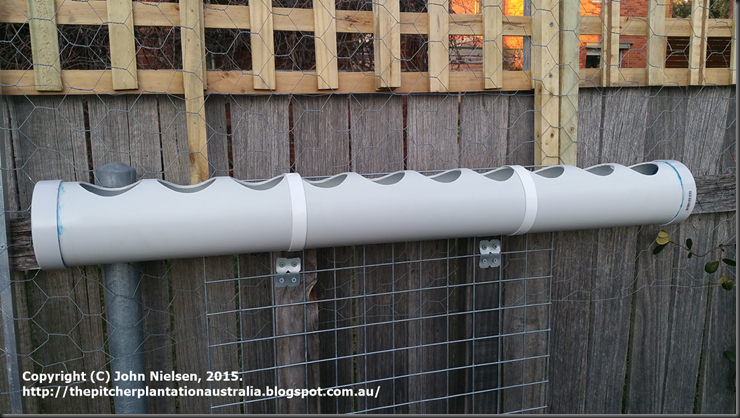
After my glue had dried, I used the C-clamps to attach the pipe to a fence. Make sure you fit washers to each screw used to ensure a good fix to your surface. Also, line up the C clamps so they fit over the a space between two adjacent pipe holes before you drill, as shown. And before you tighten the clamps all the way up, make sure the holes are level so water will not overflow out of one side. I used spare washers to make sure the pipe was level, which will in turn ensure a level water table. I will hook this pipe garden up to the irrigation system for the rest of the garden using two tricklers. I will also fill the pipe with water once cured and figure out where to drill drainage holes so the peat will not be waterlogged (I will be aiming to place the drain small holes at about 75% the depth of the actual water level in the pipe).
Next up: filling with CP mix and planting out.








